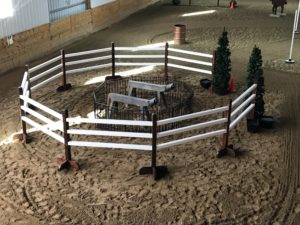Working Equitation Basics
There’s something for every horse and rider at any level with Working Equitation. Everyone can be competitive within their level.
Levels for Everyone (Novice to Pro)

Is designed for green riders and/or horses or those new to Working Equitation. A Canter not is required/allowed in the dressage trial or the Ease of Handling trial. Two hands may be used on the reins. There is no speed or cattle phases for Introductory riders.
Novice A & B (Levels 2 & 3)
This level is for riders progressing in their Working Equitation development. The Canter is required in the Dressage and in Ease of Handling trials. Lead changes are done through the trot. Two hands may be used on the reins. Novice A requires that riders walk or trot obstacles with a canter in between obstacles. Novice B requires that most obstacles are cantered unless otherwise specified.
Intermediate A & B (Levels 4 & 5)
This level is for riders progressing in their Working Equitation development. The Canter is required in the Dressage and Ease of Handling trials. Lead changes are simple changes (through the walk) in Intermediate A and flying changes are required in Intermediate B (L5). Two hands may still be used on the reins.
Advanced (Level 6)
Designed for riders advanced in their Working Equitation training. Canter is required in the Dressage and Ease of Handling trials. Changes at canter must be flying changes. One hand must be used on the reins.
Masters (Level 7)
This level’s requirements are same as WAWE (World Association of Working Equitation). Canter is required in Dressage and Ease of Handling trials. Changes at canter must be flying changes. One hand must be used on the reins.
Tack and Attire
*Important– all competitors under the age of 18 must wear an ASTM/SEI approved safety helmet.
*There is no penalty for the use of protective headgear or a protective safety vest for the rider in any class.
